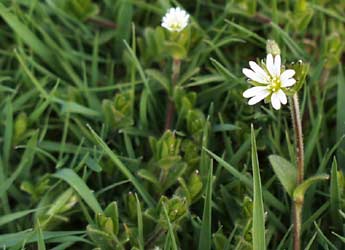Mouse-ear Chickweed (Cerastium vulgatum)

Mouse-ear chickweed is a cool season perennial that reproduces by seeds and occasionally by creeping stems that may root where they touch the soil. It has shallow, fibrous roots. The mat-forming plants grow up to 20 inches tall and have weak, hairy, spreading stems. Mouse-ear chickweed leaves are opposite, dark green, very hairy, and less than 1 inch long and up to 1/2 inch wide. They are without petioles and are oval to elliptical. The small, white, flowers have five white petals that are notched at the tips. Hairy, leafy sepals are found beneath the flowers that appear April through July.
Occurrence
Mouse-ear chickweed grows in cool, moist soils, and shaded sites.
Non-Chemical Control
Maintain dense, healthy turf using good management. Hand-pull removing entire plants.
Chemical Control
Apply postemergence broadleaf herbicides during periods of active growth from late spring through early summer and again from early autumn through early winter; apply preemergence products in mid to late summer.



